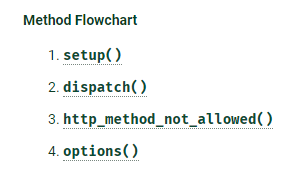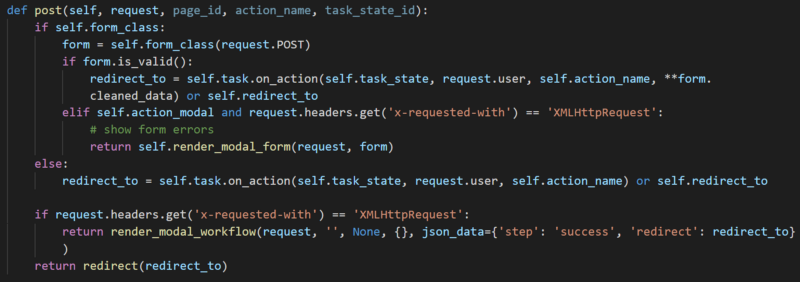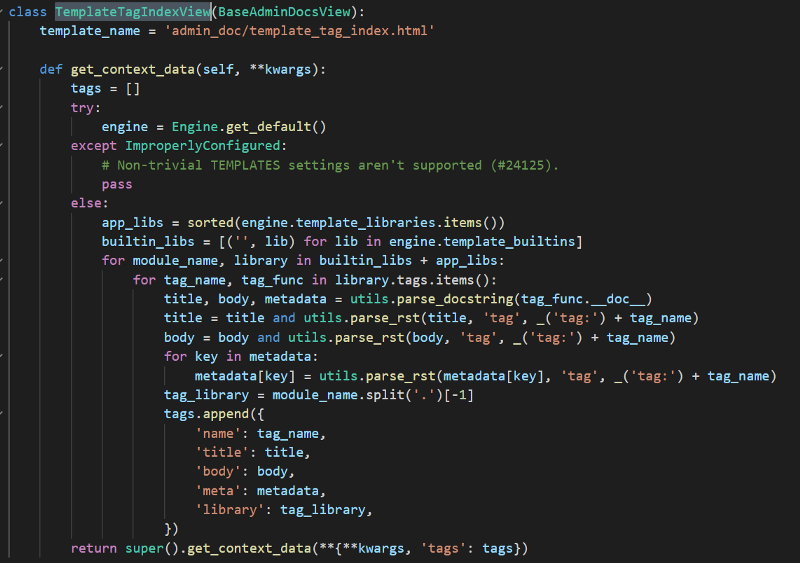How To Get Started Hacking Django Based Applications
Django is a python based web framework. In this writeup, i will teach you how to analyze django based applications . For this writeup, i will be using wagtail for examples. When doing static code analysis, for me , the most important part is identifying how routes are registered and handled, that is what we will cover in this writeup.
Before we start, i recommend you having visual studio code, since it is lightweight and its easy to analyze code using it, you can just use ctrl+click on functions to follow their definitions which helps alot. But, you can still use an editor of your choice if you want.
Url Dispatcher
All django applications has a file called urls.py. This file contains all the url endpoint available in the application. There are 3 function that allows us to register our endpoints, path, re_path, and url. path is the main way to register endpoints. re_path is like path but support regex. url is just a reskin of re_path. Lets take a look at wagtail for example.
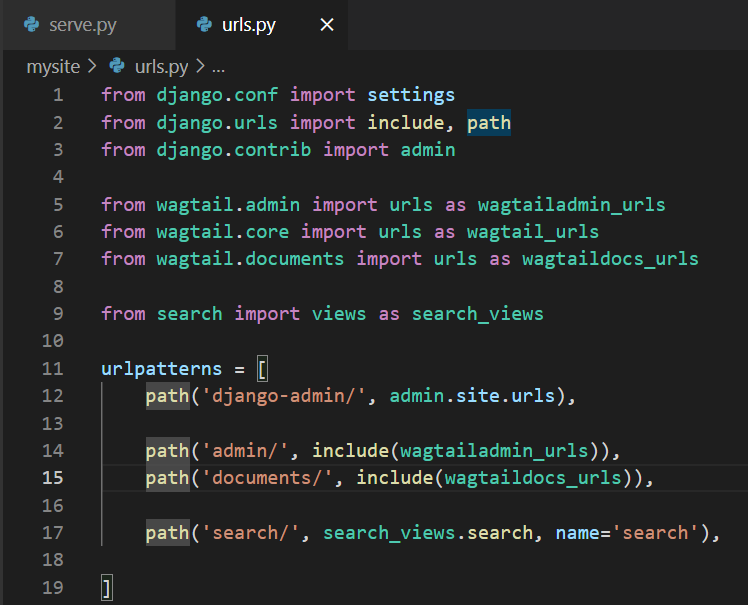 Here, you can see that 4 endpoints are registered using the path function. The second argument is the callback function that will be called when that endpoint is accessed. In line 17, when we access the search/ endpoint, it will call the
Here, you can see that 4 endpoints are registered using the path function. The second argument is the callback function that will be called when that endpoint is accessed. In line 17, when we access the search/ endpoint, it will call the search_views.search function. The name argument is not that important. Alternatively, we can also provide another list of endpoints in the second argument, like what is done in line 12, 14, and 15. In line 14 for example, it includes wagtailadmin_urls
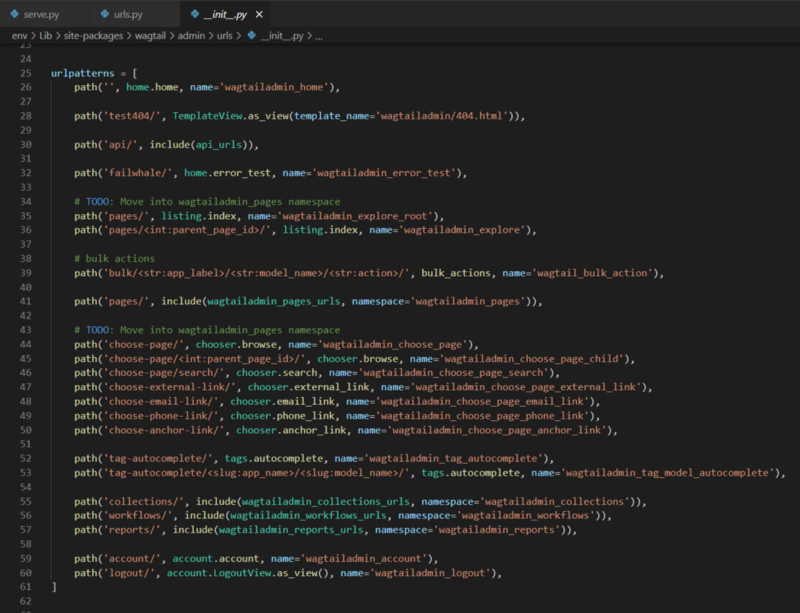 Now if we access for example
Now if we access for example admin/account/ it will call the account.account function as seen in line 59.
There are times where we need certain parts of the url as a variable, just like in line 39, in this case, the variables will be passed as an argument to the function to be called. If you follow the bulk_actions function, you will see this.
 The first argument is always the request, and the second, third, and fourth argument is the variable from the url path.
The first argument is always the request, and the second, third, and fourth argument is the variable from the url path.
Class Based Views
This is by far the most confusing part for me. But, i will try to make it as simple as possible.
There are times where you see this in the callback.
 This means, that it is using a class based view. In the django, there has a class called View. According to the django documentation, this is the flowchart of the View class
This means, that it is using a class based view. In the django, there has a class called View. According to the django documentation, this is the flowchart of the View class
The setup is the setup, not that important for us, the dispatch, is the function that actually handles the request. By default, it checks the method of the request, check if it is in the http_method_names variable, and call the associated function to the method. For example, if the http method is post, it will call the post function. The http_method_not_allowed is self explanatory, and the options function handle the request if the http method is option. This View class is supposed to be inherited by other class.
Lets take the LoginView from wagtail as an example, on its roots, LoginView inherits the class ProcessFormView, which inherits the View class.
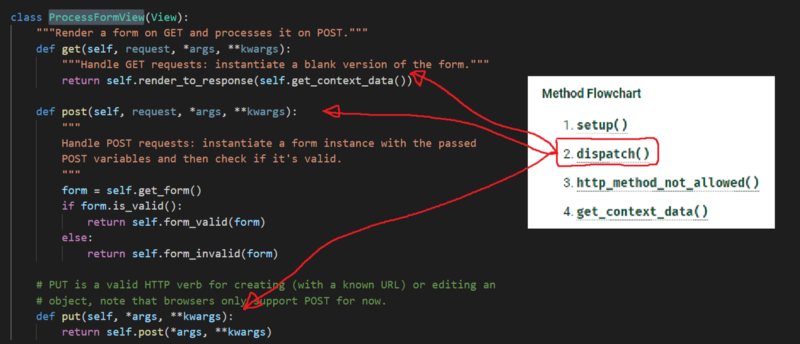 So when the
So when the LoginView.as_view function is called, the dispatch function from the View class will be called. It will check the http method and execute the corresponding function depending on the http method.
The class LoginView inherits this ProcessFormView. And you can see in LoginView the form_valid function, which handles the authentication. This form_valid function is called from the ProcessFormView class from above in the post function.
 Lets take another View class as an example.
Lets take another View class as an example.
 Here, it uses the class TemplateView.
Here, it uses the class TemplateView.
 Like before, when the
Like before, when the as_view function is called, it will call the dispatch function, which check if the http method is get, if it is, call the get function. It also inherits two more class, TemplateResponseMixin and ContextMixin. This provide the required functionalities in the get function. In the get function, you can see that it calls the render_to_response function which is a function in the ContextMixin class. What it does is render the template.
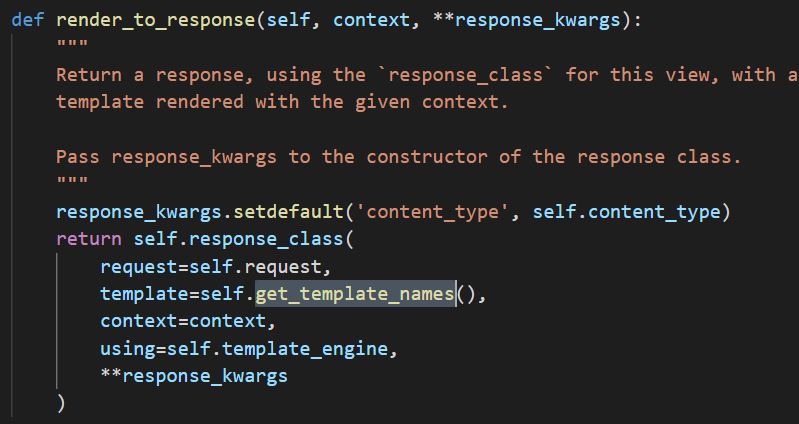 The
The get_template_names just return the template_name variable.
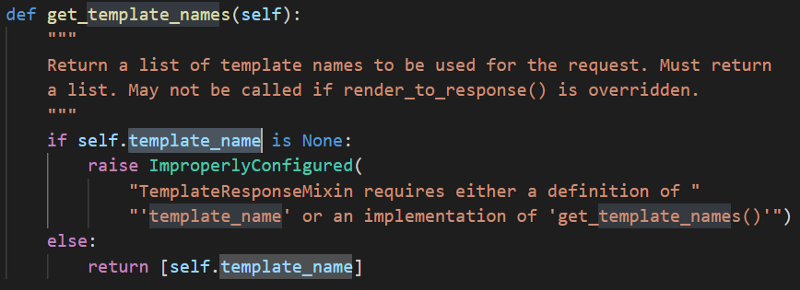 As you remember, we set the value of this
As you remember, we set the value of this template_name when routing the endpoint.
 So to summarize, when the
So to summarize, when the TemplateView.as_view is called, it will call the dispatch function, which checks if the http method is get, if it is it will call the get function in the TemplateView class, the get method, calls the render_to_response which render the template we provided in the template_name.
Class based view is really confusing so i’ll add another example, you can skip to the next part if you want.
 Here, you can see that it uses the class
Here, you can see that it uses the class WorkflowAction. WorkflowAction inherits BaseWorkflowFormView which inherits the View class.
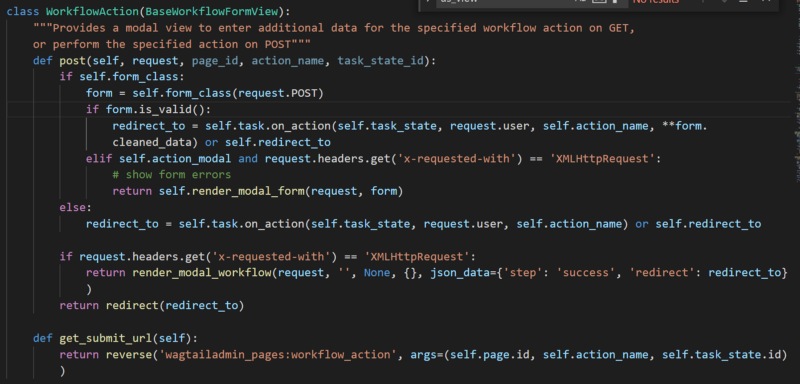 In the
In the BaseWorkflowFormView, you can see that it overrides the dispatch function.
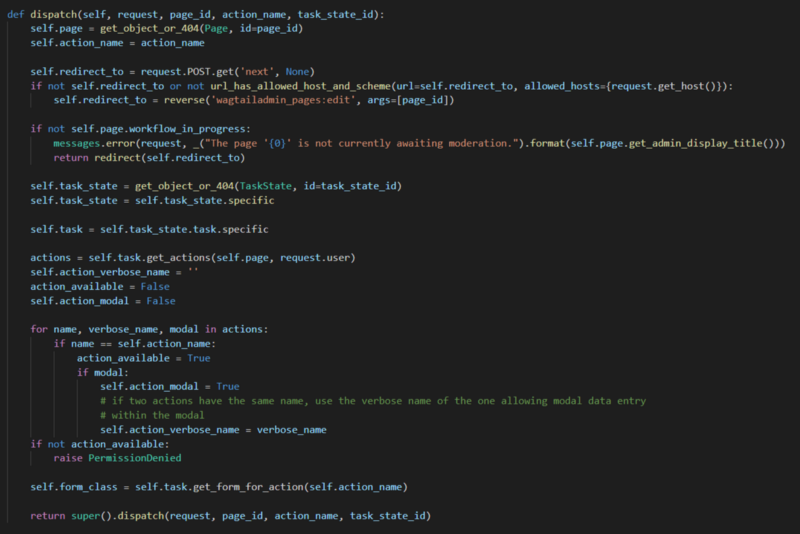 I wont go to what it does but in the end of the dispatch, you can see that it calls the original dispatch method of the super class, which is the View class to continue the flow of the original View Class. Like before, the dispatch method in the View class checks the http method, and call the corresponding function. You can see in
I wont go to what it does but in the end of the dispatch, you can see that it calls the original dispatch method of the super class, which is the View class to continue the flow of the original View Class. Like before, the dispatch method in the View class checks the http method, and call the corresponding function. You can see in BaseWorkflowFormView that it has both get and post function,
 but the post function is overridden by WorkflowAction when that class inherits
but the post function is overridden by WorkflowAction when that class inherits BaseWorkflowFormView so this post method is called instead when the http method is post.
Templates
In django, pages are often times rendered using templates. We will use the tags/ as an example.
Here, it uses the class TemplateTagIndexView
Which inherits BaseAdminDocsView
which inherits TemplateView. We already talked about TemplateView above. So, we know that TemplateView has a get function, which renders the template with a context provided by get_context_data.
From the screenshots above, you can see that the template_name variable is overridden by the TemplateTagIndexView class. Now you can see that there is a parameter in render_to_response called context, the context is like a variables used by the template when rendering. These context are just dictionaries.
The TemplateTagIndexView class override the get_context_data function.
You can see that it makes a new dictionary called tags, and add it to the original get_context_data. This variables are then used when rendering the template.
End
This is the end of the writeup, by now, you should know how a django application operates and how to test it. Normally, i made these writeups as a reference for myself when i want to tackle django hacking again, but i decided to publish it. Thanks for reading.
Join the bounty hunter discord server: https://discord.gg/bugbounty
